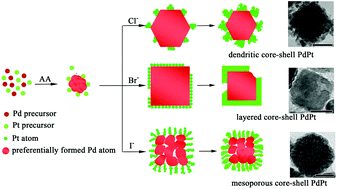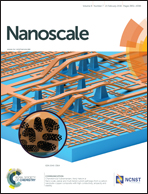PdPt bimetallic nanoparticles enabled by shape control with halide ions and their enhanced catalytic activities†
Abstract
In this study, a new and convenient one step approach is described for synthesizing shape controlled PdPt bimetallic nanoparticles. It is found that the resultant morphologies of these PdPt nanoparticles can be well controlled by simply altering the participation of different halide ions that serve as shape controlling agents in the reaction solution. The dendritic core–shell PdPt bimetallic nanoparticles generated with Pt atoms adopt usual island growth pattern in the presence of Cl− ions, whereas the introduction of Br− ions with a relatively strong adsorption effect facilitate the formation of a layered core–shell structure due to the layered growth mode of Pt atoms on the exterior surface of the central Pd core. Moreover, the stronger adsorption function of I− ions and the resulting fast atomic diffusion promoted the generation of mesoporous core–shell PdPt bimetallic nanoparticles with many pore channels. In addition, the size of these synthesized PdPt nanoparticles exhibited a significant dependence on the concentration of the halide ions involved. Due to their specific structural features and synergistic effects, these PdPt catalysts exhibited shape-dependent catalytic performance and drastically enhanced electrocatalytic activities relative to that of commercial Pt black and Pt/C toward methanol oxidation.


 Please wait while we load your content...
Please wait while we load your content...